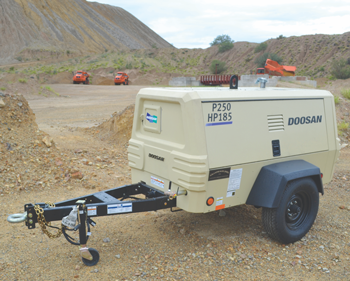Rental Solution: Dual-Pressure/Flow Air Compressors
One machine, multiple applications create more rental opportunities.Air compressors are one of the most versatile pieces of compact equipment in the construction industry. Basic construction job sites require the use of many tools, and often need an air compressor to operate them.
 |
| For customers with job sites that require flexibility, a dual-pressure/dual-flow air compressor is a cost-effective option that delivers the pressure and flow options typical of two units in a single unit. |
Whether your customers are powering pneumatic tools, abrasive blasters, paint sprayers or maintaining sprinkler systems, it’s essential to have the right air compressor for their applications.
Compressor selection
Selecting the right air compressor requires matching the volume and pressure output with the intended application. Since each tool has a cfm and psi rating listed on the machine tag, a general rule of thumb is to match the cfm rating information to the weight of a tool. For example, a 90-pound breaker requires 90 cfm, and a 60-pound breaker needs approximately 60 cfm. If a customer is planning to operate a handful of air tools, add the cfm for all tools to find the total cfm, then add 5 to 10 percent cfm to compensate for overhead. So, if you have three breakers at 50 cfm and factor 10 percent overhead, you need 165 cfm.
From a cost perspective, get as close to the application as possible, but keep in mind any future expansions and some overhead in terms of cfm. For instance, occasionally adding a 44 cfm rivet buster to the mix would make a 250 cfm compressor the better choice.
Pressure ratings are also important in air compressor selection. Most general construction applications require a pressure rating of at least 100 psi, while blasting, painting and drilling require air pressure in the 250 to 350 psi range. An air compressor pressure rating is often indicated in the model nomenclature. For instance, Doosan Portable Power air compressor models marked with P indicates a pressure rating of 100 to 125 psi while XHP indicates pressure of 250 psi or greater. In other words, a P185 air compressor operates at 185 cfm at 100 psi. An XHP1170 air compressor operates at 1170 cfm at 365 psi.
Over/under sizing risks
Selecting an air compressor is fairly straightforward if your customer is planning to complete one job at a time. However, most job sites have varying needs in air pressure and volume. To overcome this challenge, some job sites use two units to meet the varied volume and pressure needs, such as a low-pressure P250 compressor for multiple air drills and breakers and a HP185 for abrasive blasting.
Other customers are inclined to use an undersized or oversized air compressor to avoid the cost, transport and time involved with renting more than one air compressor at the jobsite. But operating an undersized or oversized unit can have more hazard than benefit.
A compressor won’t perform above its maximum output so an undersized unit won’t deliver enough air to power tools. An air hammer won’t hit as hard or as fast, slowing production.
An air compressor that’s too big for an application will increase fuel cost without any boost in productivity. Also, an oversized air compressor can damage air tools and the compressor.
Two machines in one
For customers with job sites that require flexibility, a dual-pressure/dual-flow air compressor is a cost-effective option that delivers the pressure and flow options typical of two units in a single unit. A dual-pressure/dual-flow unit changes from a low-pressure to a high-pressure with a simple flip of a switch, accomplishing a wide range of applications, including general construction, abrasive blasting and structural steel spray painting.
In addition to the obvious cost savings of one machine versus two, the ability to switch modes instead of switching machines saves time and transport costs for your customers.
Separate air compressors on a job site often leaves one machine sitting idle. With a dual-pressure/dual-flow air compressor, customers can have one compressor on site that can accomplish high- and low-pressure applications.
Rental rewards
Adding dual-pressure/dual-flow air compressors to the fleet can help rental centers expand rental capabilities while controlling cost. The adaptability to any job site and general ease of operation make it the perfect complement to any rental fleet.
The two-in-one design offers many cost-of-ownership advantages, including a lower price compared to buying two separate units, lower fuel cost and less maintenance than two machines.
The added versatility of dual-pressure/dual-flow unit also opens more rental opportunities than a single-setting air compressor. The variable pressure and flow settings are ideal for a wide range of applications that require day-to-day flexibility, including general construction, road and bridge work and pipeline testing.
Offering a dual-pressure/dual-flow air compressor in a rental fleet allows rental managers to serve multiple industries and expand rental opportunities with one machine.
This article originally appeared in the May-June 2018 issue of Pro Contractor Rentals magazine. ©2018 Direct Business Media. All rights reserved.









